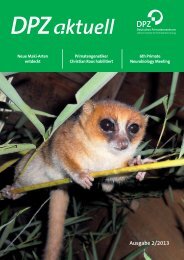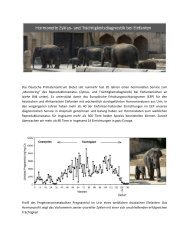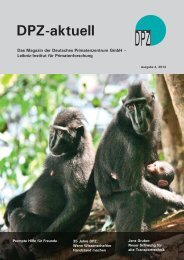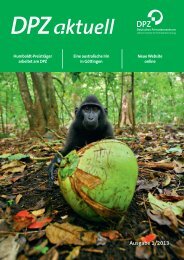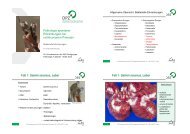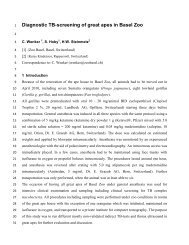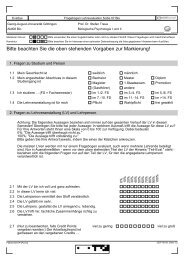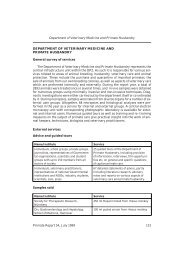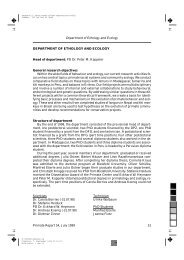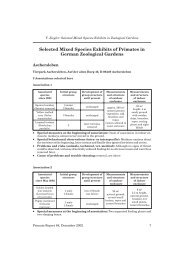Vol. 15 - Deutsches Primatenzentrum
Vol. 15 - Deutsches Primatenzentrum
Vol. 15 - Deutsches Primatenzentrum
You also want an ePaper? Increase the reach of your titles
YUMPU automatically turns print PDFs into web optimized ePapers that Google loves.
Lemur News <strong>Vol</strong>. <strong>15</strong>, 2010 Page 73<br />
consommées pour chaque site sont significativement très<br />
différentes. La corrélation entre la consommation de jeunes<br />
feuilles et les activités exercées est toujours positive et significative<br />
quel que soit le site. Les femelles choisissent un niveau<br />
plus haut des arbres que les mâles à Valohoaka et à Talatakely<br />
par contre à Sakaroa c’est l’inverse. La cohésion du<br />
groupe est plus observée dans le site intact par rapport à celui<br />
dégradé.Bref,la perturbation influe les activités générales<br />
et la structure de l’habitat de Propithecus edwardsi.<br />
Mots-clés:Propithecus edwardsi, Lémuriens, Degré de perturbation,<br />
Habitat, Activités, Parc National de Ranomafana,<br />
Madagascar.<br />
Polowinsky, S.Y. 2009. Nutrition of captive Sclater’s lemurs<br />
(Eulemur macaco flavifrons GRAY, 1867) and crowned<br />
lemurs (Eulemur coronatus GRAY,1842),with special emphasis<br />
on the problem of obesity. PhD dissertation, Biology<br />
and Geography, University of Duisburg-Essen, Germany.<br />
This study was concerned with the obesity problem of blueeyed<br />
black lemurs and crowned lemurs in captivity. Its aims<br />
were to optimize the species’ diet in captivity by combining<br />
data obtained from individuals kept at different European<br />
zoos as well as from wild blue-eyed black lemurs to gain a<br />
better understanding of the ecological and nutritional needs<br />
of Eulemur macaco flavifrons in order to prevent individuals<br />
from becoming obese and to assist planned conservation<br />
measures.<br />
The captive part of the study was conducted in two European<br />
zoos:Cologne Zoo (Germany) and Parc Zoologique<br />
et Botanique de Mulhouse, Sud-Alsace (France). A longterm<br />
study with one group of blue-eyed black lemurs<br />
(1.3) and one group of crowned lemurs (1.2) was carried<br />
out at Cologne Zoo.In addition,three groups of blue-eyed<br />
black lemurs (2.1; 1.1; 1.1) and three groups of crowed<br />
lemurs (2.2; 2.1; 3.2) were studied at Mulhouse Zoo. The<br />
body weight development of captive individuals was registered<br />
and compared to body weight data of wild individuals.<br />
The obesity rate in captivity was recorded. An obese<br />
animal was identified as one weighing more than two standard<br />
deviations over the mean wild weight. Moreover,<br />
nutrient and energy intake of Eulemur macaco flavifrons<br />
and Eulemur coronatus at Cologne Zoo and Mulhouse Zoo<br />
were registered. In addition, digestibility trials were conducted.<br />
Samples of feeds and faeces were analyzed using<br />
Weende analysis and detergent analysis. In Madagascar,<br />
four groups of Eulemur macaco flavifrons in two forest fragments,one<br />
mainly primary forest and the other predominantly<br />
secondary forest,were observed.Samples of plants<br />
utilized by free-ranging blue-eyed black lemurs were collected.They<br />
were botanically classified and analyzed using<br />
Weende analysis and detergent analysis.<br />
The mean body weights of Eulemur macaco flavifrons as well<br />
as Eulemur coronatus in captivity were significantly higher<br />
than the mean body weight of free-ranging individuals.100<br />
% of the Eulemur macaco flavifrons sample and 33.3 % of<br />
the Eulemur coronatus sample were obese.Significant body<br />
weight differences were found between the groups studied<br />
at Cologne Zoo and Mulhouse Zoo, which could be<br />
explained by different feeding regimes. Comparing the<br />
diet of free-ranging blue-eyed black lemurs to the zoo<br />
diets that were based mainly on fruits and vegetables at<br />
Cologne Zoo and Mulhouse Zoo, considerable differences<br />
were found with respect to NDF,ADF,ADL and crude<br />
protein content, whereas ash and crude lipid content varied<br />
only slightly.The NFC and energy content in the zoo<br />
diets were almost twice as high as those in the diet of wild<br />
blue-eyed black lemurs. The high NFC,crude protein and<br />
metabolizable energy content and low fibre content of<br />
the zoo diets as compared to the wild diet,combined with<br />
a relatively high apparent digestibility of ~80 % for Eulemur<br />
macaco flavifrons and ~84 % for Eulemur coronatus, respectively,<br />
and in combination with lemurs’ typically low basal<br />
metabolic rates, all clearly contribute to the obesity problem<br />
of captive Eulemur macaco flavifrons.<br />
The presented data of food consumed by Eulemur macaco<br />
flavifrons in captivity and in the wild reveals elementary<br />
differences concerning nutrient and energy composition.<br />
Although a bright variety of fruits and vegetables could<br />
protect animals in captivity from stereotypic behaviour, a<br />
systematic reassessment of the zoo diet is suggested:<br />
increasing fibre content and decreasing energy density by<br />
feeding vegetables,and whenever possible,fresh plant material<br />
in appropriate quantities instead of energy-rich<br />
fruits, gruel or commercial feeds. Although the utilization<br />
of the food fibre content by a generalist frugivore like Eulemur<br />
macaco flavifrons or Eulemur coronatus is limited, fibre<br />
content plays an important role in the maintenance of<br />
physiological health. A zoo diet corresponding to the natural<br />
requirements of lemurs guarantees an optimization<br />
of breeding programmes and presents a valuable and necessary<br />
contribution to the preservation of these highly<br />
endangered species.<br />
Key words: Eulemur macaco flavifrons, Eulemur coronatus,<br />
Nutrition, Digestibility, Obesity, Captivity, Energy intake.<br />
Rafaliarison R.R. 2010. Activité générale du Prolemur simus:<br />
transition saison sèche - saison de pluies et activité de la<br />
femelle avant et après mise bas dans le Parc National<br />
Ranomafana.Département de Paléontologie et d’Anthropologie<br />
Biologique, Université d’Antananarivo, Madagascar.<br />
Cette étude a été réalisée dans la parcelle 3 du parc national<br />
Ranomafana qui abrite le seul groupe du parc.Elle nous<br />
aidera à mieux comprendre les variations de l’activité générale<br />
du Prolemur simus pendant la transition de la saison<br />
sèche à la saison de pluie ainsi que la variation de l’activité<br />
de la femelle avant et après mise bas. Les résultats ont<br />
montré que le Prolemur simus a dépensé la moitié de leur<br />
temps à l’alimentation suivi du repos. Les variations de la<br />
fréquence de l’activité sont en relation avec la partie consommée<br />
(tige, moelle ou jeunes pousses), la disponibilité<br />
alimentaire,la température et la pluie ainsi que la disponibilité<br />
en eau.La strate la plus utilisée est comprise entre 0<br />
à 5 m. La présence d’un nouveau né a une influence sur<br />
l’activité et la proximité des individus du groupe. Pour la<br />
femelle, il y a une diminution de la fréquence de l’alimentation<br />
après la mise bas.Il y a aussi une augmentation très<br />
marquée de la fréquence du repos après la mise bas.Le juvénile<br />
s’éloigne de la femelle après mise bas tandis que le<br />
mâle reste toujours près de la femelle.<br />
Mots clés: Prolemur simus, Activités, Mise bas, Parc National<br />
Ranomafana, Madagascar.<br />
This study was carried out in Parcel 3 of Ranomafana National<br />
Park,where the only group of Prolemur simus within<br />
the park is present.It concerns the variation in the general<br />
activities of P.simus during the transition from the dry season<br />
to the rainy season as well as the activity of the female<br />
before and after giving birth.The results showed that P. simus<br />
spent half of their time feeding, followed by resting.<br />
The variation in frequency of activities was related to the<br />
consumed plant parts (trunk,culm pith or bamboo shoot),<br />
availability of food,temperature,rain and the availability of<br />
water. The most frequently used forest stratum was between<br />
0 and 5 m of height. The presence of the new-born<br />
had an influence on the activity and the spacing of the individuals<br />
in the group.For the female,there was a reduction<br />
of the frequency of feeding after giving birth. There was<br />
also a very marked increase in the frequency of resting after<br />
birth. The juvenile stayed away from the female after<br />
she had given birth,but the male always remained close to<br />
the female.<br />
Key words:Prolemur simus,Activity,New born,Ranomafana<br />
National Park, Madagascar.<br />
Raharivololona,B.M.2010.Intestinal parasite infection of the<br />
gray mouse lemur (Microcebus murinus, J.F. Miller, 1777) in<br />
the south-eastern littoral forest of Madagascar. PhD Dissertation,<br />
Hamburg University, Hamburg, Germany.<br />
Madagascar’s plants and animals belong to one of the most<br />
unique and threatened biotas of the world. Lemurs are<br />
the flagship species associated with the biological crisis of<br />
the island and notably vulnerable to habitat degradation.<br />
While most studies on the effect of habitat destruction<br />
on species survival have focused on population reduction<br />
and forest degradation, indirect effects, such as altered<br />
parasite loads have received little attention. Parasitologi-





